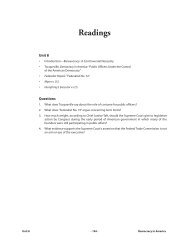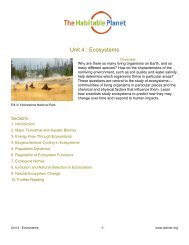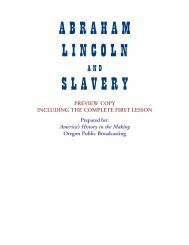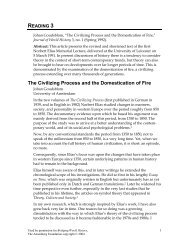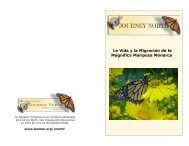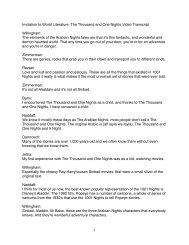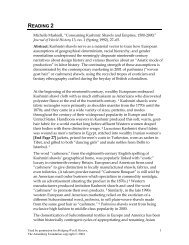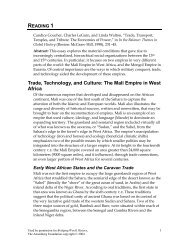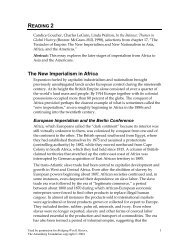UTOPIAN PROMISE - Annenberg Media
UTOPIAN PROMISE - Annenberg Media
UTOPIAN PROMISE - Annenberg Media
Create successful ePaper yourself
Turn your PDF publications into a flip-book with our unique Google optimized e-Paper software.
40 UNIT 3, <strong>UTOPIAN</strong> <strong>PROMISE</strong><br />
century romanticized visions of Native Americans as “noble savages”<br />
relate to Puritan and Quaker ideas about Native Americans?<br />
Why do you think the “noble savage” concept became so popular<br />
later in American history?<br />
Exploration: How do white Americans’ attitudes toward Native<br />
Americans through the centuries compare to their attitudes toward<br />
other non-white groups?<br />
Puritan Typology: Living the Bible<br />
The Puritans developed typology as a mode both for reading scripture<br />
and for understanding the significance of historical and current<br />
events. In its strictest sense, typology refers to the practice of explicating<br />
signs in the Old Testament as foreshadowing events, personages,<br />
ceremonies, and objects in the New Testament. According to typological<br />
logic, Old Testament signs, or “types,” prefigure their fulfillment or<br />
“antitype” in Christ. Applied more broadly, typology enabled Puritans<br />
to read biblical types as forecasting not just the events of the New<br />
Testament but also their own historical situation and experiences. In<br />
this way, individual Puritans could make sense of their own spiritual<br />
struggles and achievements by identifying themselves with biblical<br />
personages like Adam, Noah, or Job. But this broad understanding of<br />
typology was not restricted to individual typing; the Puritans also<br />
interpreted their group identity as the fulfillment of Old Testament<br />
prophecy, identifying their community as the “New Israel.”<br />
Tied to their typological understanding of their communal identity<br />
was the Puritans’ belief that they had entered into a covenant with<br />
God. Like the Old Testament Hebrews, the Puritans felt themselves to<br />
be a “chosen nation,” a people through whom God would fulfill his<br />
divine plan on earth. Their covenant, however, was not the same as the<br />
Old Testament covenant God had formed with the Israelites. The coming<br />
of Christ had changed the terms of the contract, enabling them to<br />
live under a “covenant of grace.” According to this doctrine, God had<br />
freely extended salvation to the Puritans—salvation that did not have<br />
to be earned through good works, only accepted with faith. Right<br />
behavior would follow from acceptance of and faith in the covenant.<br />
On an individual level, Puritans agonized over the status of their<br />
covenant with God (that is, their election), but as a group they were<br />
more confident. Having entered into voluntary church covenants, and<br />
thus into a kind of national covenant with God, they were assured of<br />
the centrality of their role in the cosmic drama of God’s plan. Like the<br />
Israelites of old, they had received a “special commission” from God<br />
and had come to the New World to fulfill their mission.<br />
The typological implications of the Puritans’ covenant theology are<br />
apparent in “A Model of Christian Charity,” the sermon John Winthrop<br />
delivered on board the Arbella while traveling to New England.<br />
Proclaiming that “the God of Israel is among us” and has formed a<br />
“near bond of marriage between him and us, wherein he hath taken us<br />
to be his,” Winthrop interprets the Puritans as the antitype of the Old



